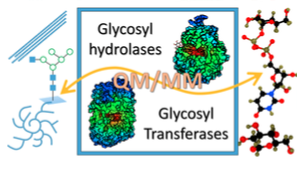Reaction mechanisms in carbohydrate-active enzymes: glycoside hydrolases and glycosyltransferases. Insights from ab initio QM/MM dynamic simulations
Reaction mechanisms in carbohydrate-active enzymes: glycoside hydrolases and glycosyltransferases. Insights from ab initio QM/MM dynamic simulations
A. Ardèvol, C. Rovira
J. Am. Chem. Soc., 137 (2015) 7528 (Perspective). Editor’s choice & JACS Spotlight.

Carbohydrates are critical macromolecules in biochemistry and cell biology, notably in immunity and intercellular communication. Enzymes that help build, degrade, and modify these sugars are attractive targets for drug development, and also find major use in industrial biotechnology. But carbohydrates are often highly complex and flexible structures, ones that are synthetically challenging, and studying their intimate chemistry has proved difficult. In this Perspective, we review new molecular dynamics simulations using quantum mechanics and molecular mechanics (QM/MM) techniques that have fostered understanding of the mechanisms and conformational dynamics of two important classes of carbohydrate-active enzymes in the past decade. The two classes, glycosyl hydrolases and glycosyltransferases, catalyze the hydrolysis and synthesis, respectively, of glycosidic bonds between carbohydrates and their partner molecules. The results of the QM/MM simulations have fueled ongoing debate over which of several proposed mechanisms these enzymes follow.
